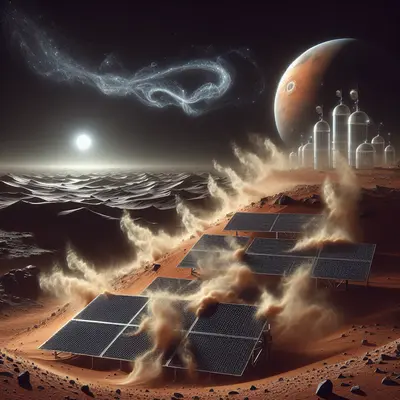Dust Mitigation Strategies for Solar Panels on Mars: Engineering Solutions for Global Dust Storms in Colonization Efforts
Abstract
This paper explores dust mitigation strategies for solar panels during Martian global dust storms, a critical challenge for sustainable power generation in Mars colonization. Using first principles reasoning, we break down the physics of Martian dust and solar energy capture to propose innovative solutions. Challenges such as reduced insolation and dust accumulation are analyzed, with proposals including electrostatic repulsion and hybrid power systems. Further research needs are identified, drawing on current studies from NASA and ESA.
Introduction
Mars colonization hinges on reliable energy sources, with solar power being a primary candidate due to its abundance and scalability. However, global dust storms, which can envelop the planet for months, pose severe risks to solar panel efficiency. This work builds on foundational frameworks for practical Mars colonization, such as the First Principles Framework for Practical Mars Colonization, by focusing on dust mitigation as a key enabler for self-sufficiency.
Background on Martian Dust Storms
Martian dust storms arise from the planet’s thin atmosphere (primarily CO2 at ~6 mbar pressure) and fine regolith particles (1-10 micrometers in diameter). These storms, occurring roughly every 1-3 Mars years, can reduce surface insolation by up to 99%, as observed during the 2018 storm that ended the Opportunity rover’s mission (NASA Opportunity Mission). Dust particles are electrostatically charged due to interactions with solar wind and triboelectric effects during wind transport, leading to adhesion on surfaces like solar panels.
Challenges for Solar Panels
Solar panels on Mars face dual threats: atmospheric attenuation of sunlight and physical deposition of dust. Dust layers as thin as 1 gram per square meter can reduce efficiency by 20-40%, with global storms exacerbating this through sustained low light levels. The low gravity (0.38g) and lack of liquid water limit natural cleaning mechanisms present on Earth. Current rovers like Perseverance use Ingenuity’s helicopter for occasional cleaning, but scaled habitats require autonomous, energy-efficient solutions (NASA Perseverance Power Systems).
First Principles Reasoning
Applying first principles, we deconstruct the problem: (1) Energy input is solar photons; (2) Output is electrical power via photovoltaic conversion; (3) Interference is opaque, adhesive dust. Fundamentals dictate that mitigation must minimize energy loss while consuming minimal power. Dust adhesion stems from van der Waals forces and electrostatics in the dry, low-pressure environment. Thus, solutions should leverage Martian conditions—abundant solar UV for charging, electrostatic properties of dust—rather than importing Earth-based water or mechanical brute force.
Proposed Solutions
Electrostatic Repulsion Systems
Charge solar panel surfaces with opposite polarity to dust particles using low-voltage electrodes (e.g., 100-500V). NASA’s Electrodynamic Dust Shield (EDS) technology demonstrates 98% dust removal efficiency in lab tests under simulated Martian conditions. Implementation: Transparent ITO electrodes on panel covers, powered by a fraction of panel output. During storms, periodic pulses lift dust into the thin atmosphere for wind dispersal (NASA EDS Technical Report).
Mechanical and Vibrational Cleaning
Integrate piezoelectric actuators or electromagnetic shakers to vibrate panels at resonant frequencies (10-100 Hz), dislodging dust without abrasion. First principles: Mars’ low gravity reduces settling velocity, aiding removal. Hybrid with tilted arrays (30-45° angle) promotes gravitational sliding. ESA studies show vibrations can restore 90% efficiency, though energy draw (1-5% of output) requires optimization (ESA Dust Mitigation Research).
Advanced Surface Coatings and Hybrid Power
Apply superhydrophobic or photocatalytically active coatings (e.g., TiO2 nanoparticles) that degrade dust bonds under UV exposure. For redundancy, hybridize with radioisotope thermoelectric generators (RTGs) or stored battery banks, ensuring 20-50% baseline power during storms. First principles scaling: RTGs provide steady heat/power, complementing intermittent solar, but mass constraints favor solar dominance post-initial deployment.
Autonomous Monitoring and AI Optimization
Deploy sensor networks (photodiodes, electrostatic voltmeters) with AI algorithms to predict storms via atmospheric data from orbiters and trigger mitigation preemptively. This reduces unnecessary energy use, aligning with colonization’s need for autonomy.
Items Requiring Further Research
While promising, these strategies need validation: (1) Long-term durability of coatings under Martian radiation and thermal cycling; (2) Energy efficiency of EDS in real low-pressure, dusty winds; (3) Scalability for habitat-scale arrays (e.g., 1 MW systems); (4) Integration with in-situ resource utilization for manufacturing cleaners; (5) Behavioral modeling of dust during prolonged storms using Mars analog sites like Utah’s deserts.
Conclusion
Dust mitigation is pivotal for Mars solar power viability, enabling self-sufficient colonies. By reasoning from first principles and leveraging electrostatics inherent to Mars, we can achieve resilient energy systems. Ongoing collaboration between NASA, ESA, and private entities like SpaceX will accelerate these technologies toward near-term milestones.
References
– NASA Global Dust Storm Analysis: Hubble Mars Observations
– SpaceX Starship Power Concepts: SpaceX Starship
